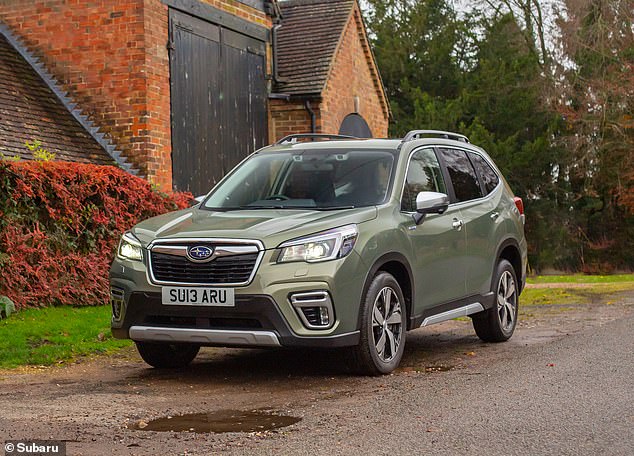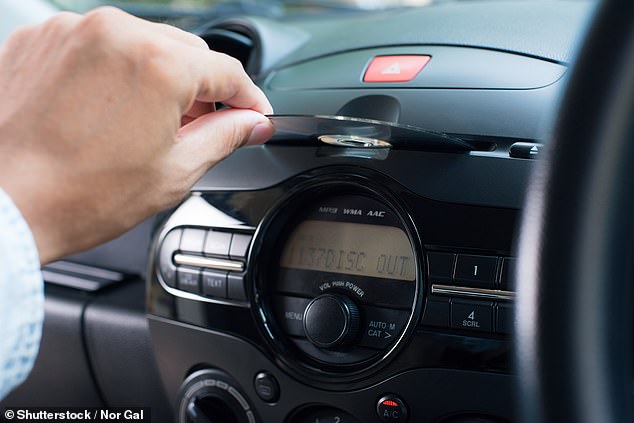The end of the road for the car CD player – no new models are now sold with this player, as the last car manufacturer is discontinuing it
An entertainment system that has been in cars for 40 years has now completely disappeared from new models. And many drivers will be angry about that.
The in-car CD player is officially dead after the last manufacturer to offer one stopped shipping it. Like all other brands, it has turned to streaming services.
While this will free motorists from having to stuff their cars with cases of CDs, it also raises concerns about driver distraction, as drivers now have to wade through infotainment system menus to change tracks and switch between favourite artists.
End of the road for the in-car CD player: Which? confirms that no new car comes with a CD player as the market shifts to streaming services. But could this be more distracting?
According to Which?, Subaru was the last brand to sell a model with a built-in CD player.
But that changed this year.
The Japanese automaker removed the CD player from the Forester SUV as part of a model update earlier in 2024.
As part of the facelift, the CD player has been replaced by built-in streaming services via Apple CarPlay and Android Auto or by connecting to a smartphone via USB. This brings the Forester in line with the rest of the model range.

Subaru was the last brand to sell a model with a built-in CD player. The Japanese automaker ditched its CD player on its Forester SUV as part of a model update earlier in 2024
This marks the end of forty years of CD players in cars. Mercedes-Benz was the first to offer the technology in 1985 as a successor to the cassette player.
The last new model with a cassette deck has recently disappeared. Lexus still sold one in its SC model until 2009.
Although cars with a large CD changer system (often located in the boot or glove compartment) have not been sold in the UK for many years, last year you could still find a number of new models with a single-disc player.
These included the Subaru XV, Porsche 718 and Lexus LC.
But now that the Subaru Forester is no longer equipped with a modest CD player, an era has truly come to an end, according to Which?, after the company said it had combed the entire new car market as part of its research.
Of all the current new vehicles available, the Isuzu D-Max pickup truck is the only one available with a CD player.
At the time of writing, three of the four trim levels come with such a trim, so make sure you don’t accidentally buy the non-trim version when you’re in the market for a truck.
Not surprisingly, not everyone will be happy with the news of the demise of CD players in cars.
CD sales rose 3.2 percent year-over-year in the first half of 2024, according to data from the Digital Entertainment and Retail Association.
And there are already complaints from motorists that they cannot play their CD in their new car.
As part of the latest annual Which? Car Reliability Survey, drivers were asked what frustrates them most about their car. Many respondents said they were unhappy with the CD player.
“Very disappointed that there was no option to have a CD player fitted,” said one owner of a Ford Focus Estate (2018 to present), while a driver of a Dacia Sandero (2013-2021) noted: “I regret the lack of a CD player.” Many other owners simply exclaimed: “No CD player!”

CD sales are expected to grow 3.2% year-over-year in the first half of 2024, according to data from the Digital Entertainment and Retail Association. And many drivers still prefer to have one instead of plugging in their smartphone or using a streaming app on the infotainment screen.
Loss of CD players creates even more distraction behind the wheel
New car buyers must now familiarize themselves with the world of streaming music on the go.
That certainly has its advantages, not least of which is that you can listen to a huge library of songs in your car – certainly more than would be possible with a wallet full of CDs.
And with many cars connecting seamlessly to your phone through Android Auto and Apple CarPlay, streaming from services like Amazon Music and Spotify has never been easier.
However, operating streaming services through infotainment screens is also a distraction for drivers on the road.
Independent automotive safety authority Euro NCAP announced earlier this year that it would downgrade the safety ratings of cars without physical buttons to control five key functions, due to concerns about distraction.
From January 1, 2026, vehicles without physical buttons or switches for turn signals, hazard lights, horn, windshield wipers and SOS functions will also receive lower crash test scores.
Matthew Avery, Director of Strategic Development at Euro NCAP, explains: ‘The overuse of touchscreens is an industry-wide problem. Almost all car manufacturers are moving key controls to central touchscreens, forcing drivers to take their eyes off the road and increasing the risk of distracted accidents.
‘New Euro NCAP tests scheduled for 2026 will encourage manufacturers to use separate, physical controls for basic functions in an intuitive way. This will reduce the amount of time the car takes its eyes off the road and promote safer driving.’
The growing trend to remove buttons and equip touchscreens with more controls is said to ‘undermine’ the ban on using a phone while driving. From March 2022, drivers who touch their device will receive six penalty points on their licence and a £200 fine (and if they are caught by police or roadside cameras within two years of passing their licence, their licence will be revoked).
Road safety experts have been warning for years that the latest cars are becoming increasingly dangerous.
Designers love using larger, high-resolution screens because it removes what they see as unnecessary ‘clutter’ from the dashboard, creating a clean, minimalist look.
Industry analysts also prefer this setup because it saves costs by eliminating switches and wiring, instead using an iPad-style dashboard controlled by downloadable software.
Some links in this article may be affiliate links. If you click on them, we may earn a small commission. That helps us fund This Is Money and keep it free. We do not write articles to promote products. We do not allow commercial relationships to influence our editorial independence.
